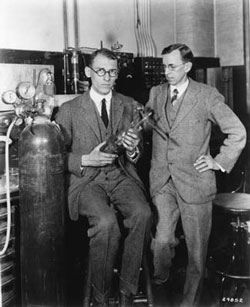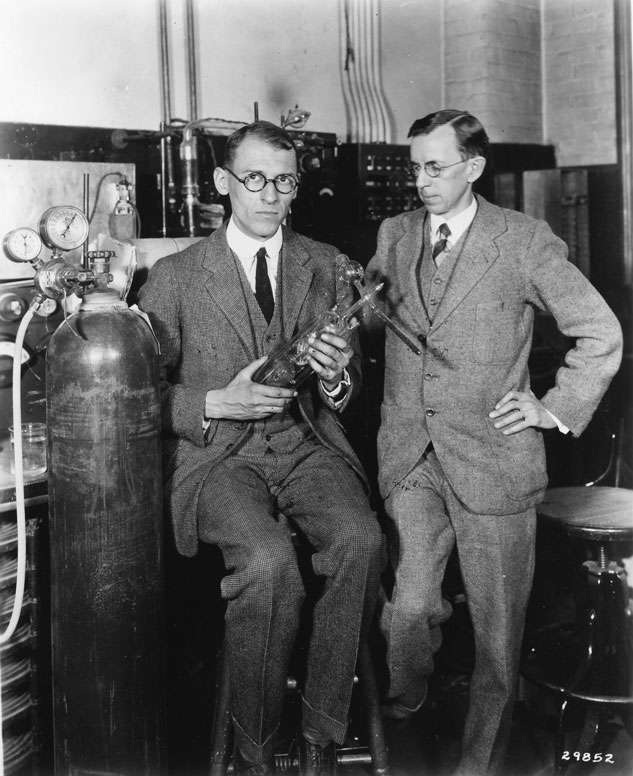Landmarks: Electrons Act Like Waves
APS has put the entire Physical Review archive online, back to 1893. Focus Landmarks feature important papers from the archive.
A 1927 paper in the Physical Review demonstrated that particles of matter can act like waves, just as light waves sometimes behave like particles. Clinton Davisson and Lester Germer of the Bell Telephone Laboratories, then in New York, found that electrons scatter from a crystal in the same way that x rays do. The work began as a result of a laboratory accident and ultimately earned Davisson a Nobel Prize.
In 1924, Louis de Broglie, a graduate student at Paris University, proposed that matter, like light, has a dual nature. The next year, graduate student Walter Elsasser of the University of Göttingen in Germany proposed a way to test it: If electrons do have a wave nature, they should, like light, exhibit wave phenomena such as diffraction. In one form of diffraction, a light beam passing through a regular series of holes or slits, called a grating, exhibits “dark spots” in directions where the wave troughs coming from some holes cancel the peaks coming from others. “Bright spots” appear in directions where the peaks reinforce one another. A beam of tiny marbles, as electrons were conceived of until this point, could never show such cancellation and enhancement.
By chance, Davisson and his junior partner Germer were well-positioned to quickly follow Elsasser’s suggestion. They had been attempting to probe the structure of the atom by firing low-speed electrons at nickel and measuring the scatter. Their experiments weren’t turning up anything of interest, and in 1925 they were saved from frustration and ultimately obscurity by an accident. Their equipment broke, and extreme heating recrystallized their nickel target into a few large crystals, where previously there had been many smaller ones. Their data, showing the amount of scattered electrons at each detector position, began exhibiting some intriguing peaks.
It was only later, when Davisson discussed his results with physicists during his 1926 summer vacation in England, that he learned of de Broglie’s theory and realized that his data likely contained the world’s first glimpse of electron diffraction. The atoms in the recrystallized nickel had acted as a grating. Following this realization, Davisson and Germer began a deliberate search for diffraction patterns, especially the peaks in their data plots that would indicate extra electrons scattering in specific directions. After some disappointing initial results, they found a single peak that agreed both with de Broglie’s theory and with separate experiments using x rays in place of electrons. Eventually they found 30 peaks, 29 of which could be explained by diffraction. One was left unexplained, and they failed to find eight additional peaks that they had expected to appear.
The team published a short paper in Nature in early 1927 [1] and then a more complete article later that year in the Physical Review. George Paget Thomson of the University of Aberdeen in Scotland published his own experimental proof of electron diffraction just a month later [2] and shared the 1937 Nobel Prize in physics with Davisson.
Davisson and Germer are often misrepresented as “experimentalists setting out to validate a theoretical prediction,” says Spencer Weart, director of the Center for History of Physics at the American Institute of Physics in College Park, Maryland. In fact, once they learned of de Broglie’s theory, they simply adapted an experimental program that had been underway for another purpose, says Weart. “This is one of many cases where experimenters got data which they learned only later were relevant to a theory that they had never set out to check.”
–Chelsea Wald
In 2006 Chelsea Wald was a science writing intern at APS. Now she is a freelance science writer in the Netherlands and the author of Pipe Dreams: The Urgent Global Quest to Transform the Toilet (Simon & Schuster, 2021).
References
- C. J. Davisson and L. H. Germer, Nature (London) 119, 558 (1927)
- G. P. Thomson and A. Reid, Nature (London) 119, 890 (1927)





